Aerial robotics
Friendly visitor
The SailMAV drone can fly and sail on water due to its foldable wings. Its special design also allows it to record wildlife behavior, as animals do not perceive the drone as a hostile intruder.

Gliding along quietly and still getting to your destination – research can be that simple. The ultralight SailMAV drone flies to remote waters and sails there quietly, saving energy. In this way, the small flying robot (Micro Aerial Vehicle, or MAV) can collect data on the biodiversity of, say, a remote alpine mountain lake or an Arctic fjord. "Water birds or mammals on the shore are not disturbed by SailMAV, so the drone can make unbiased statements about the effects of climate change on the state of the ecosystem, for example," explains André Farinha.
Farinha is one of the drone's developers, a team of researchers from Empa's Sustainability Robotics Laboratory in Dübendorf and the Aerial Robotics Laboratory at Imperial College London. Their challenge: to teach the sailing drone to fly, even though the design specifications for movements on the water and in the air are contradictory. Says Farinha, "We were finally able to optimize the aerodynamic properties after mathematical modeling and building a few prototypes so that SailMAV can actually sail on the water like a catamaran and fly with its wings wide open."
To enable the small drone to manage the change of location from one body of water to the next, it folds the sides of its three-part high-performance wing into a horizontal position within two seconds, giving it a wingspan of just under a meter. Farinha's team constructed the flying robot from polymer foam with a tenth-of-a-millimeter-thin carbon shell and coated it with a water-repellent nanoparticle layer. As a result, SailMAV weighs just 520 grams. Under lab conditions, the fast and agile drone makes the transition from water to air in just a few seconds and within a distance of less than ten meters.
The researchers are now working on ensuring that SailMAV can also do this under real-world conditions in wind and weather. In future, SailMAV will also be equipped with more complex sensors that will allow the inconspicuous bird friend to fly and sail autonomously.
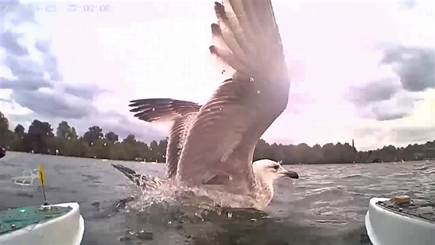
A drone for every occasion
Empa researchers are developing drones for all aspects of the environment, represented as the four "elements" of fire, water, earth and air. Illustration: Empa
Andre Farinha
Sustainability robotics
Phone: +41 58 765 4672
Prof. Dr. Mirko Kovac
Laboratory of Sustainability Robotics
Phone: +41 58 765 4689
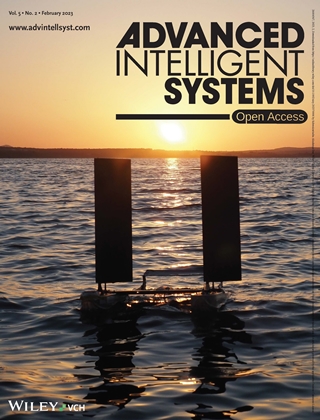
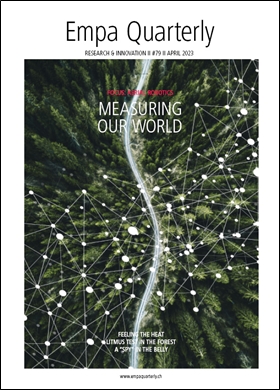
Empa Quarterly#79 Aerial robotics
They fly through fire, sneak past birds, and collect data from the heart of rainforests without leaving a trace: In the current issue, we feature drones with unusual capabilities. In the planned "DroneHub," researchers want to develop and test even more versatile flying robots. And for those who prefer to keep their feet firmly on the ground, the issue also features research projects on quantum technology, medicine, building materials and green electronics.
Read the EmpaQuarterly online or download the pdf-version.
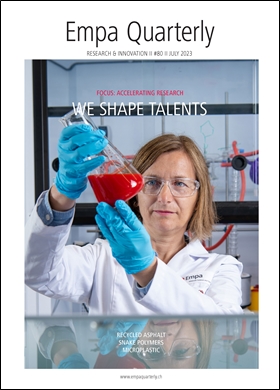
Empa Quarterly#80 Accelerating research
The young people of today are the decision-makers of tomorrow. In this issue, the focus is therefore not (only) on materials and technologies, but also on the people who make them possible: Researchers, founders, apprentices and students. Through support at all professional and academic levels, these talents can reach new heights in science or enter the Swiss economy as urgently needed skilled workers.
Read the latest EmpaQuarterly online or download the pdf-version.
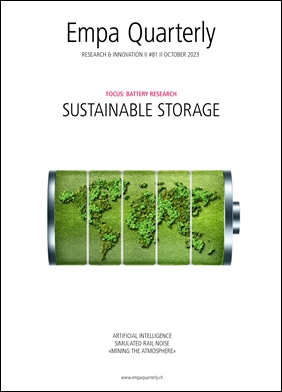
Empa Quarterly#81 Battery research
Being able to store energy is a central pillar of a sustainable energy system, since solar and wind energy are not always available in sufficient quantities when they are needed. Good batteries are indispensable for the energy transition, and thus for a more sustainable world. Empa researchers are developing batteries for different applications, from stationary energy storage to electromobility. They are also working on analyzing and recycling end-of-life batteries.
Read the latest EmpaQuarterly online or download the pdf-version.
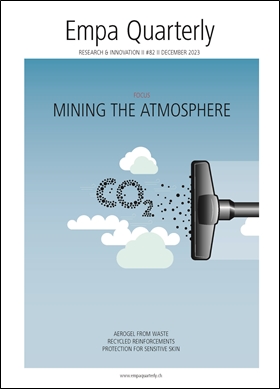
Empa Quarterly#82 Mining the Atmosphere
To limit climate change, we need to compensate not only for future emissions, but also for historical ones. One solution would be the "atmospheric vacuum cleaner": we remove the excess CO2 from the atmosphere. But what do we do with it? Instead of extracting the carbon for polymers, medicines, fibers, fuels and the like from crude oil, we use atmospheric CO2. This is the simple – yet extremely challenging in technical terms – idea behind Empa's new research initiative, Mining the Atmosphere.
Read the EmpaQuarterly online or download the pdf-version.
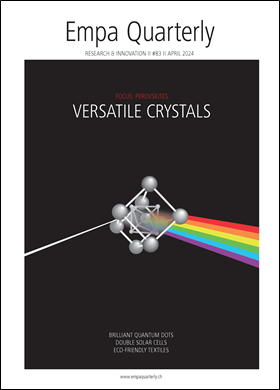
Empa Quarterly#83 Perovskites: Versatile cristals
Over 180 years ago, a curious crystal was discovered in the Ural Mountains. Today, it has given rise to an entire class of materials that is of great interest to researchers: perovskites. What all perovskites have in common is their crystal structure, which gives them unusual properties. By changing the exact composition of the perovskite, scientists can control these properties. Empa researchers are using this promising material to develop solar cells, detectors and quantum dots.
Read the EmpaQuarterly online or download the pdf-version.
-
Share






